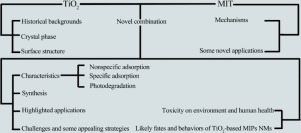Journal of the Taiwan Institute of Chemical Engineers ( IF 5.7 ) Pub Date : 2018-06-19 , DOI: 10.1016/j.jtice.2018.05.035 Cui Lai , Xiangxiang Zhou , Danlian Huang , Guangming Zeng , Min Cheng , Lei Qin , Huan Yi , Chen Zhang , Piao Xu , Chengyun Zhou , Rong Zhong Wang , Chao Huang

|
Over the past 40 years, Titanium dioxide (TiO2) has focused continuously growing worldwide concern due to its novel characteristics such as large specific surface area, powerful oxidation strength, and chemical stability. Nevertheless, its poor selectivity restricted its promising application in specific detection and selective removal of target pollutants in mixing solution, especially the low concentration of highly toxic pollutants. Importantly, concerning on the formation of selective sites with the memory of a template, molecular imprinting technologies (MIT) can selectively remove the template and their structural analogues. With the appealing characteristics of combination of TiO2 and MIT, the TiO2-based molecular imprinting polymers (MIPs) can selectively detect and photo-degrades targets, and are widely utilized in chemical sensors, solid-phase extraction and artificial antibodies. Thus, we review the significant progress of MIT and highlighted applications of TiO2-based MIPs during the past 10 years, especially emphasis on their origins, structure, functions, affecting factors, up-to-date development and main challenges faced in improving their working efficiency. Additionally, the review also covered the ecotoxicological effects of TiO2-based MIPs nanomaterials (NMs) in environment and human beings.
中文翻译:

二氧化钛及其在环境分子印迹技术中的突出应用综述
在过去的40年中,二氧化钛(TiO 2)由于其新颖的特性(例如大比表面积,强大的氧化强度和化学稳定性)而引起了全球关注,并引起了越来越多的关注。然而,它的选择性差限制了它在混合溶液中特异性检测和选择性去除目标污染物方面的应用前景,特别是低浓度的高毒性污染物。重要的是,关于通过模板记忆形成选择性位点,分子印迹技术(MIT)可以选择性地去除模板及其结构类似物。凭借TiO 2和MIT结合的吸引力,TiO 2分子印迹聚合物(MIP)可以选择性地检测和光降解靶标,并广泛用于化学传感器,固相萃取和人工抗体中。因此,我们回顾了麻省理工学院的重大进展,并重点介绍了基于TiO 2的MIP在过去10年中的应用,特别强调了其起源,结构,功能,影响因素,最新发展以及在改善其质量方面面临的主要挑战。工作效率。此外,该综述还涵盖了基于TiO 2的MIPs纳米材料(NMs)在环境和人类中的生态毒理作用。



























 京公网安备 11010802027423号
京公网安备 11010802027423号